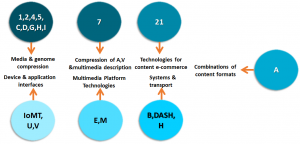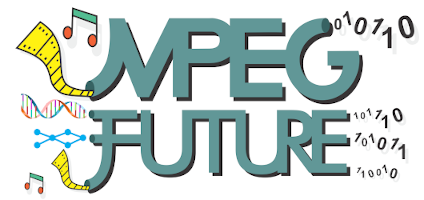The benefits of the MPEG Future proposal
MPEG Future makes a clear proposal for the future of MPEG: inject new elements of innovation while moving MPEG and with its successful standardisation model up one layer in the ISO hierarchy – from Working Group (WG) to Subcommittee (SC). What is the value of this proposal? Moving up in the hierarchy? That would not even be worth mentioning.
So, let’s make an analysis of the value of the MPEG Future proposal on the basis of the following parameters, currently of the first 6. More will be coming soon.
| Governance | Execution of work plan | Synergies inside MPEG |
| Strategic planning | Joint work with others | Relationship with JPEG |
| Area of work | Leadership | Brand |
Governance
An ISO Working Group (WG) is typically established to carry out a specific project or a set of projects. When the goal is achieved, it is disbanded.
MPEG is a very special WG: it has been in operation for 31 years, has reached a membership of 1600 with 600 attending, has developed some 180 standards, has become the enabler of the business of its global client industries – distribution via packaged media, broadcasting and broadband/mobile networks – worth hundreds of billion USD p.a.
MPEG must have a formal governance, as the ISO/IEC directives ensures a and be the official – as opposed to proxy – interface with its client industries.
Execution of work plan
MPEG exists because it has a work plan to execute so that companies can develop new products and services. Have a look at the MPEG work plan
The MPEG Future proposal ensures that the work plan can be accomplished because the same MPEG machine that has developed and is executing the work plan as a WG, will continue to operate as an SC powered by new innovations.
Synergies inside MPEG
MPEG is not just a collection of groups, one doing video, another audio etc. It is a collection of groups interacting to produce integrated standards. This means that, to accomplish their work, the groups need to sit together and discuss how to integrate the different pieces. This is well represented by the figure below

Therefore, MPEG Future does not intend to transform the MPEG subgroup into a set of autonomous or, worse, non-communicating working groups, but enhance the MPEG ecosystem of today into similarly collaborative and interacting MPEG Working Groups.
Strategic planning
For 31 years MPEG has developed and implemented strategic plans that have been extremely beneficial to industry. With MPEG-1 it kickstarted the digital video business and MP3, with MPEG-2 it made the dream of digital television possible, with MPEG-4 it brought media to the web in a sustainable fashion, with MPEG-7 it entered the long path of media coding for machines, with MPEG-21 it developed framework and technologies for ecommerce of media and so on. A host of other standards followed, all conceived and developed by MPEG. This is a synthetic picture of how MPEG implementated its digital media standardisation strategy.

MPEG Future proposes to continue relying on MPEG’s capability to develop and then execute strategic plans.
Joint work with others
Since 1992 MPEG is successfully collaborating with ITU-T SG 16 to jointly develop standards for video coding and, in the case of MPEG-2, also for its transport. This collaboration has continued for 27 and has produced two more successful standards: Advanced Video Coding (AVC) and High Efficiency Video Coding (HEVC). Versatile Video Coding (VVC) is close to reaching Final Draft International Standard (FDIS) stage and will bring to 5 the successful collaborations.
MPEG has collaborated with many other organisations. The table below reports some of the most relevant.
| Body | Started in | Result of collaboration |
| ITU-T SG16 | 1992 |
|
| JPEG | Mid 2000s |
|
| 3GPP | Mid 2000s |
|
| JTC 1/SC 24 | 2013 |
|
| ISO TC 276 | 2016 |
|
Award do not have a value per se, but for what they mean. MPEG has received several Emmy Awards. They confirm that the industry is on MPEG side. MPEG Future wants to perpetuate this successful collaboration spirit.
Relationship with JPEG
JPEG is the MPEG sister WG. It is in charge of image coding and serves a different industry than MPEG. MPEG has provided JPEG with several technologies, such as the ISO Based Media File Format (ISOBMFF, also-called MP4 file format) and has developed standards to transport JPEG image formats. In particular the MPEG-2 transport of JPEG 2000 and their recent JPEG XS.
MPEG Future proposes that MPEG continues its successful provider-client relationship with JPEG in the same way that MPEG holds a provider-client relationship with other organisationally separate committees.
Area of work
MPEG’s track record of 180 standards, some of which wildly successful business enablers and changers, defines better than words what MPEG is. Sometimes, however, words are required and here is what MPEG Future proposes as scope for SC 4x:
Standardisation in the area of delivery of moving pictures and audio, their descriptions and other data for
- Broadcast, broadband and mobile distribution based on efficient storage, processing, delivery and consumption of digital moving pictures and audio captured with any technology
- Efficient storage, processing and delivery of genomic and other data, in agreement and collaboration with the relevant committees.
This means that MPEG is in the business of standards for all aspects of the audio-visual value chain for today’s human users but is also in charge of describing audio and video for different users, e.g. machines. Further it leverages its current successful development of genomic data compression and looks forward to investigating other domains and possibly develop standards in agreement and collaboration with the relevant communities.
Leadership
Restructuring is common in large organisations. This is typically done when it is recognised that a different organisation can do things better. This is not the case of MPEG.
MPEG Future proposes that, while MPEG is elevated to Subcommittee, it retains not only its structure because it is the result of an evolution that has lasted for 30 years, but also its leaders, who know how to best manage the organisation so that it gives its best.
Brand
The MPEG brand is synonymous of continuous innovation for the all industries involved in broadcast, broadband and mobile distribution. MPEG has been able to provide the necessary technologies to the industry catering for their continuous growth and profitability.
MPEG Future thinks that the MPEG brand is associated to the combined groups making up MPEG, not to anyone of them. The MPEG brand is a whole that must be upheld.
